
Trophallaxis is the transfer of food or other fluids among members of a community through mouth-to-mouth (stomodeal) or anus-to-mouth (proctodeal) feeding. Along with nutrients, trophallaxis can involve the transfer of molecules such as pheromones, organisms such as symbionts, and information to serve as a form of communication. Trophallaxis is used by some birds, gray wolves, vampire bats, and is most highly developed in eusocial insects such as ants, wasps, bees, and termites.

Halictidae is the second-largest family of bees with nearly 4,500 species. They are commonly called sweat bees, as they are often attracted to perspiration. Halictid species are an extremely diverse group that can vary greatly in appearance. These bees occur all over the world and are found on every continent except Antarctica. Usually dark-colored and often metallic, halictids are found in various sizes, colors and patterns. Several species are all or partly green and a few are red, purple, or blue. A number of them have yellow markings, especially the males, which commonly have yellow faces, a pattern widespread among the various families of bees. The family is one of many with short tongues and is best distinguished by the arcuate basal vein found on the wing. Females in this family tend to be larger than the males. They are the group for which the term 'eusocial' was first coined by entomologist, Suzanne Batra.

Halictus rubicundus, the orange-legged furrow bee, is a species of sweat bee found throughout the Northern Hemisphere. H. rubicundus entered North America from the Old World during one of two main invasions of Halictus subgenera. These invasions likely occurred via the Bering land bridge at times of low sea level during the Pleistocene epoch.

Lasioglossum malachurum, the sharp-collared furrow bee, is a small European halictid bee. This species is obligately eusocial, with queens and workers, though the differences between the castes are not nearly as extreme as in honey bees. Early taxonomists mistakenly assigned the worker females to a different species from the queens. They are small, shiny, mostly black bees with off-white hair bands at the bases of the abdominal segments. L. malachurum is one of the more extensively studied species in the genus Lasioglossum, also known as sweat bees. Researchers have discovered that the eusocial behavior in colonies of L. malachurum varies significantly dependent upon the region of Europe in which each colony is located.
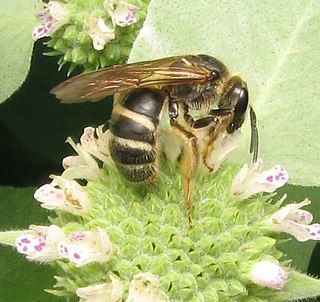
The sweat bee genus Lasioglossum is the largest of all bee genera, containing over 1800 species in numerous subgenera worldwide. They are highly variable in size, coloration, and sculpture; among the more unusual variants, some are cleptoparasites, some are nocturnal, and some are oligolectic. Most Lasioglossum species nest in the ground, but some nest in rotten logs.
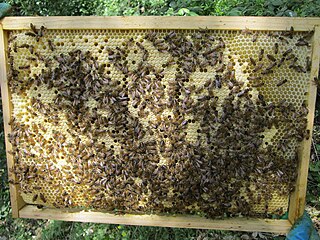
Eusociality is the highest level of organization of sociality. It is defined by the following characteristics: cooperative brood care, overlapping generations within a colony of adults, and a division of labor into reproductive and non-reproductive groups. The division of labor creates specialized behavioral groups within an animal society which are sometimes referred to as 'castes'. Eusociality is distinguished from all other social systems because individuals of at least one caste usually lose the ability to perform behaviors characteristic of individuals in another caste. Eusocial colonies can be viewed as superorganisms.

Ropalidia marginata is an Old World species of paper wasp. It is primitively eusocial, not showing the same bias in brood care seen in other social insects with greater asymmetry in relatedness. The species employs a variety of colony founding strategies, sometimes with single founders and sometimes in groups of variable number. The queen does not use physical dominance to control workers; there is evidence of pheromones being used to suppress other female workers from overtaking queenship.
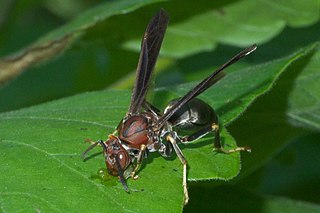
Polistes metricus is a wasp native to North America. In the United States, it ranges throughout the southern Midwest, the South, and as far northeast as New York, but has recently been spotted in southwest Ontario. A single female specimen has also been reported from Dryden, Maine. P. metricus is dark colored, with yellow tarsi and black tibia. Nests of P. metricus can be found attached to the sides of buildings, trees, and shrubbery.

Within the insect order Hymenoptera, the Halictinae are the largest, most diverse, and most recently diverged of the four halictid subfamilies. They comprise over 2400 bee species belonging to the five taxonomic tribes Augochlorini, Thrinchostomini, Caenohalictini, Sphecodini, and Halictini, which some entomologists alternatively organize into the two tribes Augochlorini and Halictini.

Lasioglossum zephyrus is a sweat bee of the family Halictidae, found in the U.S. and Canada. It appears in the literature primarily under the misspelling "zephyrum". It is considered a primitively eusocial bee, although it may be facultatively solitary. The species nests in burrows in the soil.
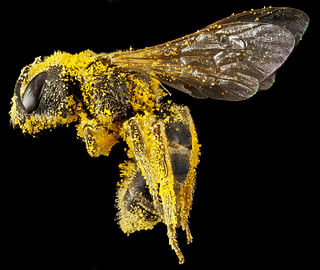
Halictus ligatus is a species of sweat bee from the family Halictidae, among the species that mine or burrow into the ground to create their nests. H. ligatus, like Lasioglossum zephyrus, is a primitively eusocial bee species, in which aggression is one of the most influential behaviors for establishing hierarchy within the colony, and H. ligatus exhibits both reproductive division of labor and overlapping generations.

Lasioglossum cressonii is a species in the sweat bee genus Lasioglossum, family Halictidae. Halictidae exhibit eusocial hierarchy behavior which is interesting given that eusociality in this group is hard to evolve and easy to lose. L. cressonii is found throughout North America. L. cressonii have been shown to be important pollinators for apple trees and many other North American native plants.

Lasioglossum hemichalceum, which has sometimes been confused with L. erythrurum, is a sweat bee endemic to Australia. Large numbers of unrelated females will typically share a single nest, a behavior referred to as "communal". Nests are constructed underground by the independent efforts of the females. L. hemichalceum will typically begin creating new colonies during the summer, with brood production from late November through the first few months of spring. Members of this species do not demonstrate aggressive behavior towards one another. As the size of the colony increases, the reproductive potential of each female does not change, unlike many species of bees.
Lasioglossum figueresi, formerly known as Dialictus figueresi, is a solitary sweat bee that is part of the family Halictidae of the order Hymenoptera. Found in Central America, it nests in vertical earthen banks which are normally inhabited by one, though sometimes two or even three, females. Females die before their larvae hatch. It was named after José Figueres Ferrer, a famous Costa Rican patriot, and studies of its behavior are now general models for social behavior studies.
Lasioglossum aeneiventre, also known as Dialictus aeneiventre, is a social sweat bee and is part of the family Halictidae of the order Hymenoptera. Found in Central America, it nests mostly on flat ground though sometimes in vertical banks. It is often compared to L. figueresi.

Lasioglossum leucozonium, also known as Lasioglossum similis, is a widespread solitary sweat bee found in North America, Europe, Asia, and parts of northern Africa. While now a common bee in North America, population genetic analysis has shown that it is actually an introduced species in this region. This population was most likely founded by a single female bee.

Halictus sexcinctus, commonly referred to as the six-banded furrow bee, is a species of sweat bee found throughout Europe and as far east as Asian Turkey and Iraq. The H. sexcinctus can be easily confused with the closely related species, Halictus scabiosae, due to very similar morphological features. H. sexcinctus show a social polymorphism in which different colonies can exhibit solitary, communal, or eusocial structure. Due to this large variance in social organization, it was suspected that it was not one species at all, but rather multiple, cryptic species. However, genetic analysis was able to confirm these varying populations as one species. H. sexcinctus will forage from multiple flower species, but prefers plant species with wide-open flowers. Their nests can be found dug into the ground in loamy or sandy soil.

Dialictus is a subgenus of sweat bees belonging to the genus Lasioglossum. Most of the members of this subgenus have a metallic appearance, while some are non-metallic. There are over 630 species worldwide. They are commonly found in the Northern Hemisphere and are found in abundance in North America. Members of this subgenus also have very diverse forms of social structure making them model organisms for studying the social behavior of bees.
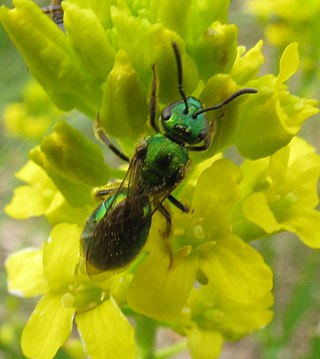
Augochlorella aurata is a primitively eusocial species of sweat bee in the family Halictidae. It is one of three species of Augochlorella found east of the Rocky Mountains in North America. The body is a brilliant green metallic color, diffused to varying extents with a copper, red, or yellow color. A. aurata is a generalist pollen feeder and likely an important pollinator for some horticultural crops. A common name is golden green sweat bee.

Megalopta is a widespread neotropical genus of bees in the tribe Augochlorini in family Halictidae, known as the sweat bees. They are the largest of the five nocturnal genera in Augochlorini. Most have pale integumentary pigmentation, and all have large ocelli, most likely a feature of their nocturnal behavior. They live in tropical Central America and the entirety of South America. The subgenus Noctoraptor is cleptoparasitic. They are not known from the fossil record.



















